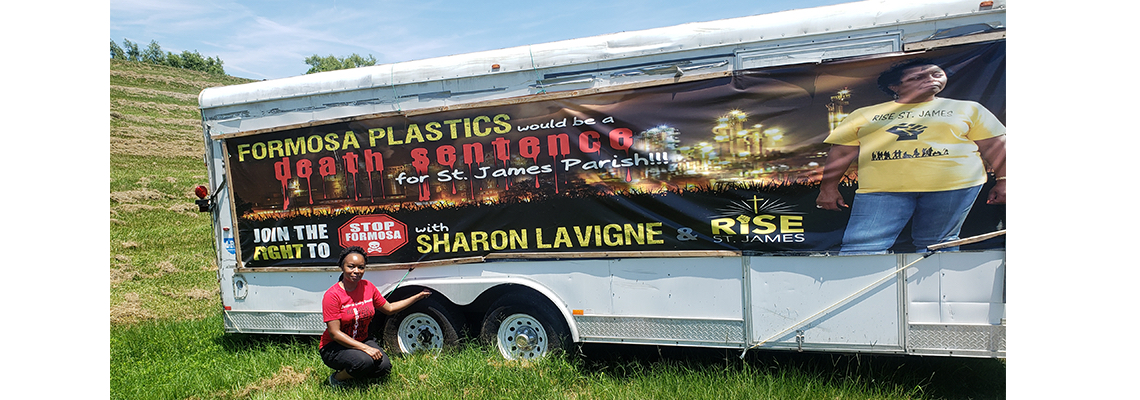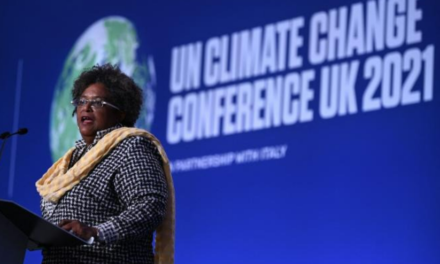
The process to make petrochemicals, which are found in everything from plastics to fertilizers to yoga pants, exposes nearby communities to serious health risks, like cancer and respiratory illnesses, says Tonya Calhoun of the Environmental Defense Fund, shown in front of banner on Cancer Alley in Louisiana.
Earth Day is an opportunity to celebrate and take part in collective action to protect our planet, stabilize our climate and safeguard public health. And this year’s theme — Planet vs. Plastics — reminds us that plastics are made from the same dirty fossil fuels that harm our health and worsen climate change impacts.
As the world transitions to clean energy and less oil and gas is used to power our homes and vehicles, the fossil fuel industry is increasingly pivoting to petrochemicals, which are found in everything from plastics to fertilizers to yoga pants. The process to make these chemicals exposes nearby communities to serious health risks, like cancer, respiratory illnesses and more.
Climate change is the greatest challenge of our time. It’s essential for communities— including and especially Black women — to stay at the table, continuing to push our leaders to build solutions that do more to protect our health.
Air pollution from the burning of fossil fuels endangers our health and our future, and many of the same sources of toxic air pollution are also the main drivers of climate change. From tailpipe pollution out of cars and trucks to the dangerous toxic air coming from power plant smokestacks and chemical plants, burning dirty, unsustainable fossil fuels is a threat to our health and our planet.
And communities don’t experience these threats equally. Black, Hispanic and Indigenous communities and low-income areas bear the brunt of exposure to pollution because the fossil fuel industry is more likely to operate in their communities. They also face the greatest threats from climate-fueled extreme weather, like heat waves, storms and floods, and have the fewest resources to rebuild after a disaster.
This is what we mean by environmental justice: remedying environmental harms that have been imposed on specific communities and preventing similar injustices from happening in the future.
But now more than ever, I’m feeling hopeful about the power of collective action to drive change. President Biden’s clean energy plan has ushered in a new era of climate progress, and recent actions from the Environmental Protection Agency, including stronger standards for soot pollution, bold investments in electric vehicles and health protections against petrochemical pollution, have positioned us to build a non-polluting energy future for healthy, thriving communities.
Years of community-led advocacy have helped push our leaders to invest in the tools we need to slash harmful pollution, protect our health and build the clean economy of the future.
The critical next step is to ensure these climate investments are rolled out swiftly and fairly across the country so that the communities facing the greatest harms from climate pollution will see the full benefits of healthier air, more resilient infrastructure and a stronger economy with good, family-supporting jobs. Central to this work is the need to ensure people and communities are at the center of solutions.
These efforts to center community needs and priorities in climate action plans are bolstered by data-driven tools like the U.S. Climate Vulnerability Index, which drills down into specific reasons why a particular community is vulnerable to climate threats—and what decisionmakers can do to get out ahead of those threats and start making investments in solutions that protect people’s health and safety.
This tool was developed in close collaboration with community leaders every step of the way, because our climate solutions are more durable and long-lasting when communities are included in the conversation.
I’m inspired by the Black women at the forefront of these efforts to create a safer, healthier future, working every day to co-create solutions with communities—leaders like Dr. Erica Holloman-Hill, who is collaborating with Environmental Defense Fund to develop a climate resiliency curriculum to advance community-driven climate action. This project will equip community members with fundamental climate literacy so that they can engage with decisionmakers and advocate for solutions that protect our health, build resiliency and stabilize our climate.
Climate change is the greatest challenge of our time. It’s essential for communities— including and especially Black women — to stay at the table, continuing to push our leaders to build solutions that do more to protect our health.
This Earth Day, I’m celebrating the enormous amount of progress we’ve made toward ending our reliance on fossil fuels. There’s more work to be done. Let’s continue to move forward together so that we can secure a healthy, thriving future for every community.
Tonya Calhoun, Ph.D., is director of community engagement for the Environmental Defense Fund.







